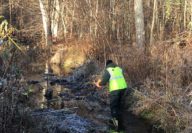by Rick Boggs, PE, SECB, LEED AP, Senior Project Manager
I felt a familiar rush of adrenaline as I pulled my car into the parking lot. Everything was prepared – we had professionally laid out information boards, a well-crafted presentation, and an activity to drive our message home. But this presentation would be different. Mike Earley, a civil engineer and the manager of Fuss & O’Neill’s Survey Group, and I, a structural engineer and project manager with more than 30 years of experience, would now face an audience as daunting and unpredictable as any we had met with before…45 third graders!
As part of Fuss & O’Neill’s Engineer’s Week, Mike and I were asked to speak to these students to share our passion and strike a spark of interest in engineering. I have recent experience mentoring high school and college students through the ACE program and other voluntary positions, but had not faced a room full of eight year olds since my now-grown daughters were, well, eight years old.

We began with a brief presentation to discuss what engineering is, why it’s important, and the kinds of things engineers do every day. The students asked all sorts of thoughtful questions, some technical and some not so technical. There were more hands in the air than we could call on, given the time constraints. But what really made an impact on the students was when Mike compared the role of the engineer to a game of Minecraft. The students responded enthusiastically, clearly signaling an “aha!” moment.

Following the Q&A session, we introduced the students to the activity we prepared for them – the design and construction of a bridge using a variety of materials, including plastic straws, Play-Doh, paperclips, and tape. The goal was a bridge that could span a single sheet of paper (8 ½ inches) and successfully support a paper cup filled with 100 pennies. As the students worked in teams, Mike, the teachers, and I walked around to advise and assist them in the challenge. They spent about 40 minutes working on the project. Though the results were mixed, the students learned quite a bit about working in a team, making and implementing design decisions, and the technical aspects of how to make a strong and stable structure. It may be years before any of these young minds choose a career in engineering, but we were thrilled to learn later that the students actually chose to spend their next recess making more bridges!
I am very proud that Fuss & O’Neill has made a commitment to inspire the next generation of technical leaders, and very happy to be a part of that effort. It is critically important to the continued health of our society to feed the pipeline with passionate and well-trained technical professionals. The interest in these disciplines starts at a young age, and students who feel that there is an end game in the form of a great career working on cool stuff are more likely to see the relevance of even the basic levels of their math and science curriculum.

While we modified our activity a little, check out the base activity here: https://www.playdoughtoplato.com/stem-project-straw-bridges/
About the Author:
 Rick Boggs, PE, SECB, LEED AP has over 30 years of experience as a structural engineer, project manager and engineering staff manager. His roles and responsibilities have included structural analysis, structural system selection and design, cost evaluation, specification preparation, peer reviews and execution and supervision of contract documents for both new and renovated building projects.
Rick Boggs, PE, SECB, LEED AP has over 30 years of experience as a structural engineer, project manager and engineering staff manager. His roles and responsibilities have included structural analysis, structural system selection and design, cost evaluation, specification preparation, peer reviews and execution and supervision of contract documents for both new and renovated building projects.
Contributions from Michael Earley, PE, LS, LEED GA
 As Survey Department Manager, Michael draws on his experience in both survey and civil engineering to customize cost-effective solutions for his clients. His multifaceted background allows him to work seamlessly with all of Fuss & O’Neill’s departments because he understands the intricacies that make up the big picture and he clearly sees the most direct path to success.
As Survey Department Manager, Michael draws on his experience in both survey and civil engineering to customize cost-effective solutions for his clients. His multifaceted background allows him to work seamlessly with all of Fuss & O’Neill’s departments because he understands the intricacies that make up the big picture and he clearly sees the most direct path to success.




